Pioneering South African dragon fruit venture builds momentum

A South African dragon fruit venture that is introducing new varieties into the country is rapidly building momentum and excitement.
The first volumes of trademarked varieties marketed under the Amorentia Sweet Dragon Fruit brand were sold on the domestic market this past summer season, and inaugural exports to Europe could take place in the coming months.
The project is still in its infancy, with around 20 hectares to have been planted by July. But Amorentia Estate and Nursery owner Howard Blight is confident of a successful future. He says the varieties have fared extremely well in consumer tastings and are performing well in hot and dry areas.
Blight has registered 14 U.S.-developed, self-pollinating varieties in the country. These are far superior to the cultivars currently under small-scale production there, he explained. A handful of these have been planted by South African growers and are now starting to come into production.
"We recently had a dragon fruit display at a local supermarket, and they sold everything within two hours," he said. With a good taste and high sugar levels, he said the newer varieties are different to what many consumers are used to.
Dragon fruit's drought resilience
From a production perspective, Blight said that the varieties have far exceeded expectations. While he had believed growers should avoid planting in areas where temperatures could exceed 40ºC, he said it has become clear that temperatures in the high 40s are "absolutely acceptable".
In addition, the water requirement is far lower than many other fruit crops.
"In one area there were two temperatures that went above 50ºC in the very hot drought we had here," he said. "But with the right water and properly designed irrigation system, those plants have grown unbelievably."
"We're now confidently saying that you'll need half the amount of water that you would need for other subtropical crops to grow a successful dragon fruit orchard.
"So not only are we able to stretch the suitability into the drier and hotter areas, but you can use considerably less water per hectare. It's very water efficient. It's the camel of the plant fraternity."
Growers utilizing additional lighting at night
There are plantings in many areas of the country where there is no risk of frost. The hoter, dryer areas of Limpopo province in the north of the country have produced very good production results during the past year. Being a long-day crop, dragon fruit requires ample sunlight and flowers two or three times during the summer.
But Blight said additional lighting is being used for a few hours on the plantations from around March to extend the growing season. Growers will harvest and evaluate their first winter crop over the next couple of months.
Along with its production-friendly attributes, the new varieties have also shown to have good shelf life.
"The shelf life is better than avocados. And they are shipped under the same regime and with similar temperatures to other subtropical crops," Blight said. They can also make use of the existing infrastructure for subtropical fruit, including packhouses, cold storage facilities and cold trucks for transporting the fruit to port.
In addition, he said the last couple of years have proved that the varieties are indeed self-pollinating. They also enter into full production in year four, which is sooner than Blight had expected.
Growers and the variety owners have an equal share in the marketing company. What's more, the chairman of the board - who will have a casting vote - will be chosen by the growers.
"This makes a huge difference. It's a whole new and fair approach toward marketing," he said.
First exports and international expansion
Blight explained the first trial exports could take place over the next year. Europe will be the target market, where he expects the Amorentia varieties will be able to compete well with the other cultivars on offer from countries like Israel, Colombia and Ecuador.
"There are a number of export companies that are interested in shipping to Europe, thanks to the work we have done with the brand and the claims we have made about the varieties," he said. "We're waiting to hear if the prices would support airfreight or if we would send by sea."
Overall, Blight said that the venture has taken a little longer than he had anticipated to get off the ground. But he said it's important to start off with the correct strategy to create a sustainable and profitable venture.
"I would conservatively believe that in the next 12 months we would have another 50 hectares planted, and from there it should rise quite steeply," he said.
Production will likely expand over the coming years to other African countries like Mozambique, Angola and Zimbabwe.
"We're really enjoying the pioneering of a new crop and the collectiveness of it. And we're getting the support and a good response for it. It's good fun."











































